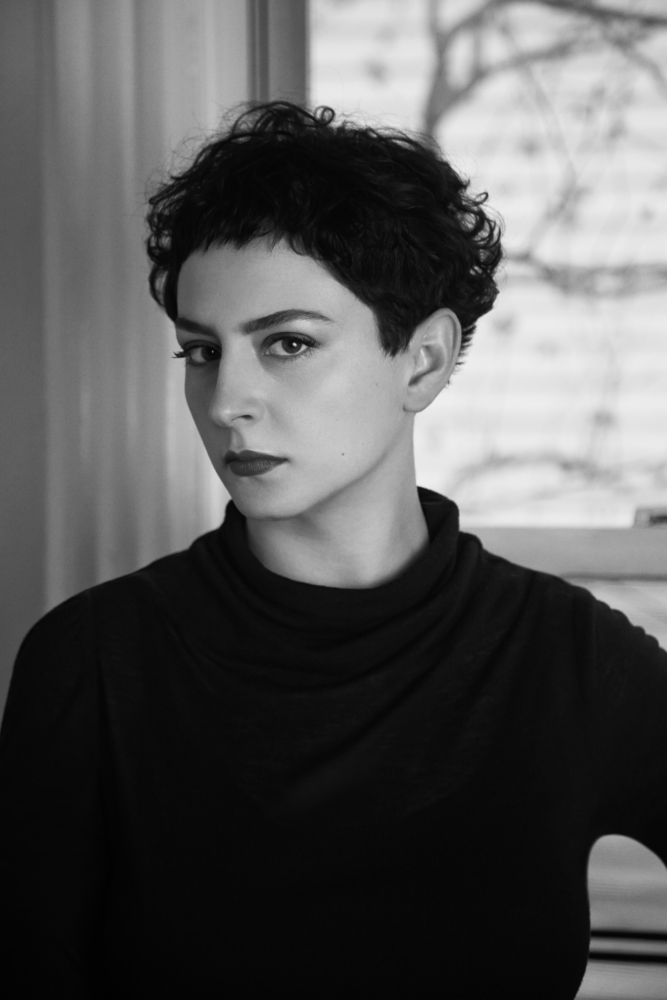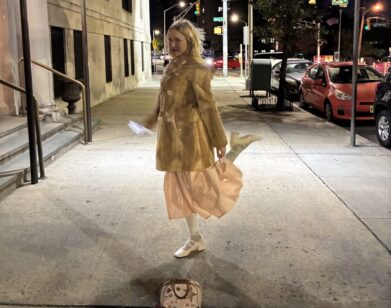Writer Kate Zambreno On Kathy Acker, Guibert, and the Paradox of the Author Photo

Photo by Tom Hines.
Writer Kate Zambreno is perhaps best known for her third book, Heroines, published by Semiotext(e) seven years ago. A deep dive into female literary modernists, the memoir-criticism hybrid defied classification before genre-defying became a literary buzz-thing. This is, in part, because Zambreno herself is an elusive narrator, deeply ambivalent about the world of publishing and persona. Her writing often feels like an automatic act, her essays speculative, fluid—fugitive even—and utterly unpindownable.
With Screen Tests, her new book from Harper Perennial, Zambreno presents fifty-five short stories—some only a line—anchored by four long essays. The title is a nod to the over 500 black and white 16mm shorts Andy Warhol made between 1964 to 1966, cinematic portraits of downtown icons like Edie Sedgwick and Nico.
The small works, which combine the concision of Lydia Davis with the satirical wit of Thomas Bernhard, may appear to be a new flash form for the novelist. But on a second look, they are a natural extension of her practice: art world adjacent explorations of our cultural landscape. Interview sat down with Zambreno last week at Cafe Mogador in the East Village to talk modern portraiture, author photos (“Franzen doesn’t look anything like his”), and philosophers hanging out in parking lots.
———
STEPHANIE LACAVA: We’re actually in the East Village now—and you start your Kathy Acker essay walking around the East Village thinking about Cookie Mueller, Nan Goldin, Lydia Lunch. You compare a young Kathy Acker to a punk Edie Sedgwick bankrolled by Sol LeWitt. And you write that the first week you moved to New York. You were asked to be on a panel on literary bohemianism, and you said no—which I think is hilarious.
KATE ZAMBRENO: Yeah, I said no. I was asked to be on a lot of panels dealing with feminism or women writing when I moved here, and most of them I said no to.
LACAVA: You go on from there in the essay to say, “The relationship of art to the market here feels psychotic. The conversations about writing here are conversations about publishing.” Do you still feel that way?
ZAMBRENO: I do. It’s funny, I wonder if either I’ve become an insider, or I’m less troubled by the psychosis of it. But I still feel that so many of the conversations about writing are conversations about publishing, and I still hate it.
LACAVA: Can you explain that for people who would say, “Oh, they’re the same thing?”
ZAMBRENO: I’ve been thinking about Marguerite Duras saying that one has to write as if one is already dead, which is the title of the little study I’m writing about Hervé Guibert. I have begun to think that for me the true project of literature is without an object. And publishing is about an object. But Duras also says—I’m reading her new collection of nonfiction that Dorothy is publishing…
LACAVA: Oh, you have that?
ZAMBRENO: It’s really good.
LACAVA: Give it here! It’s coming to me next.
ZAMBRENO: Definitely. So Duras writes that one must publish so one can finish things. But I do think that, in this time of precarity, there is this possibility to be always publishing and always public and promoting one book and never actually writing—in a private, sustained, ongoing way. And there’s that line in Renata Adler’s Speedboat about how writers don’t write, writers do a million other things instead. When I came to New York, having come from the small press scene, I was shocked how much the conversation about writing was about what books you had, who your agent was. People talk about names and who you’re supposed to represent as an author, what your name is supposed to represent. I found these mercantile conversations paralyzing, but now I find it kind of hilarious. And so I think a lot of the screen tests, which were inspired by Antoine Volodine’s Writers and Thomas Bernhard’s Voice Imitator, were like, God, being a writer is hilarious. I mean, it is. Writers, I think, are some of the funniest bunch of people. We’re desperate for attention—
LACAVA: And yet don’t want it.
ZAMBRENO: And don’t want attention.
LACAVA: There’s a lot of fear of success throughout this book.
ZAMBRENO: I’m pretty terrified of success.
LACAVA: Isn’t it the Mark Twain quote where he says, “Whenever you find yourself on the side of the majority, it’s time to pause and reflect.” Is it that feeling?
ZAMBRENO: I think it’s one of the reasons I identify with Robert Walser. This idea of being small and staying small. Maybe because I worry that if I became a success, then I would become a monster of my own making, and I would be expected to do that thing that my name represents.
LACAVA: You talk a lot about disappearance, about invisibility as a writer, and another way people achieve that is being part of a collective.
ZAMBRENO: I have a novel, Drifts, which is about these ideas. I guess it’s about process and loneliness and failure and friendship and community. What is the private impulse towards art? There’s a piece in Screen Tests called “Blanchot in a Supermarket Parking Lot…”
LACAVA: Oh, that’s my favorite one!
ZAMBRENO: The Blanchot and the Beckett pieces are thinking about their paparazzi photos.
LACAVA: Have you ever seen that video clip of the Foucault and Chomsky debate where they’re drinking this orange juice that is this incredible orange?
ZAMBRENO: No! The Guibert study I’m supposed to be writing is a little study on his book To the Friend Who Did Not Save My Life, which is partially a fictionalized narrative about his friendship with Foucault.
LACAVA: This could be the third “Beckett in Shorts”—Chomsky and his orange juice. [Laughs.]
ZAMBRENO: Then “Foucault in his Kimono.” That Guibert photograph. That title was in my head for a long time—”Blanchot in a Supermarket Parking Lot.” The piece is like a photograph, but it’s very teasingly and playfully thinking about Blanchot’s desire toward anonymity that Foucault was so obsessed with, and Blanchot’s thoughts on community and the impossibility of community. It’s this very solitary image of Blanchot as an old man—
LACAVA: At the supermarket.
ZAMBRENO: Outside the supermarket. I think that desire toward friendship and community is almost the opposite of success in publishing, which is very singular. The egotism of capitalism.
LACAVA: The idea of the collective versus the individual. You write a lot about female glamour, which is very Warholian as well. I especially love the essay where you talk about the fact that Clarice Lispector was burned by a cigarette, the same as Ingeborg Bachmann. You write about these great female beauties and writers who then lost some of their looks to fire or old age—this idea about the woman writer in front of the work.
ZAMBRENO: There’s a real crisis in the Kathy Acker essay, which is one of the first essays I wrote. I detail having my photo taken for the first time, professionally, for Jezebel, and feeling a real crisis about being this face when, I think, one of the reasons I became a writer was to not be a face.
LACAVA: To disappear, to be faceless.
ZAMBRENO: To not have a face—that’s Foucault’s line. I love Clarice Lispector and I love Ingeborg Bachmann, but I do think it’s interesting that so often when we talk about women writers, it’s always synonymous with their appearance or glamour. I think these little stories are troubling that.
Even Louise Brooks, who I write about in her old age and as a hermit, she’s only seen mournfully through her previous image. One of the things I was most shocked by when I moved to New York—but again, like everything else, I’m less shocked by now—was this concept that to be a writer here, you were expected to be an image. You were expected to be good at getting your photograph taken.
LACAVA: Just to be clear, when we started talking about this interview, you did not have an author photo.
ZAMBRENO: Not really.
LACAVA: Which I found very appropriate in the context of the interview.
ZAMBRENO: I am in no way a purist, though. I hope one of the things that I communicate in my writing is a deep ambivalence.
LACAVA: The whole book is about ambivalence.
ZAMBRENO: The author photo I use is from a fashion magazine shoot I did before I was pregnant. I haven’t gotten a new author photo taken because it just terrifies me. There’s that moment in the Kathy Acker essay when I began getting my hair cut off when I moved here. I would give the person at the salon images of David Wojnarowicz and Samuel Beckett, and Ann Quin and Ingeborg Bachmann with short hair. That’s what I wanted to project.
LACAVA: But he looks so good in shorts!
ZAMBRENO: He does look really good. But there’s this idea of wanting to be severe or scary and not wanting to be too pretty, or approachable, or too pleasing.
LACAVA: Because you feel like that makes the work less.
ZAMBRENO: I think I was wary of being made into a thing. The alienation of that.
LACAVA: That doubles back into the bookmaking—making the book into a thing. The object. You don’t want to be the object. There is a hilarious screen test in here in which you list all of the authors’ photos that you found, from Barthes, Lispector, Duras, Sontag, Genet, Bachmann, and they’re all smoking a cigarette in their author photos. And then the last line is “Thomas Bernhard is eating an ice cream cone.” [Laughs.]
ZAMBRENO: There is this desire to project the kind of coolness and allure that they project in their author photos.
LACAVA: How do you do that now, when you can’t smoke a cigarette in your author photo?
ZAMBRENO: I am the least cool person, especially when I get my photograph taken. When I meet another writer or reader, people are really surprised I look like my author photo.
LACAVA: That’s fascinating.
ZAMBRENO: Franzen doesn’t look anything like his author photo.
LACAVA: No hating on Franzen.
ZAMBRENO: [Laughs.] There’s something about the photo versus the real state of being a writer, which is, you know, often, like, being a slob and being internal, and the state of publicity brings one outside of that. I think in some ways if I was going to say what Screen Tests does, it is sending up being a minor writer who has meditated on publicity and fame and invisibility with these larger stars and figures, whether they’re a philosopher or a screen actor or, you know, Warhol, himself.
LACAVA: I think the Ray Johnson one is quite funny…Talk to me about that essay.
ZAMBRENO: A collection I was really inspired by is Andrew Durbin’s Mature Themes. Especially his digressive piece on Raymond Pettibon, “Sir Drone.” A lot of pieces call back to encountering an artist or a work of art. I had seen the Ray Johnson show at Matthew Marks [Gallery], and I had previously known about his mail art through the Siglio book. There’s something about a collage that’s mysterious and private but also laden with popular culture. I think the Ray Johnson essay is trying, in a way, to replicate the feeling of looking at a Ray Johnson collage, which is gossipy, playful, full of symbols and codes—
LACAVA: What do you make of this idea that people are saying now that writing has become more collage-like?
ZAMBRENO: I do think it’s true. I teach an undergraduate seminar on collage and writing. And one of the things that I think about the most with writing is when Hedi El-Kholti did the collages for Heroines, he said, you don’t want a collage to be perfect. You want it to have some sense of drift to it.
LACAVA: Which is the next title of your book as well.
ZAMBRENO: Yeah. That concept of driftiness, that something shouldn’t be perfect, that it should have a mystery to it, I think informs the writing that I’ve done, post-Heroines.
LACAVA: It’s interesting though because one could say that the collage is, in a way, glamourous because of the mystery that you mention—what’s left out is essentially what glamour is, to some degree.
ZAMBRENO: Although I feel that Ray Johnson—his bunny ears on everything and his little notes— undercut glamour into something very inside-jokey.
LACAVA: But then that leads us to the Sarah Charlesworth collage [that’s on the cover and is the subject of a piece in Screen Tests called “Rider”] which is probably one of the most glamorous images in the sense that it’s Natalie Wood behind this cutout of the horse.
ZAMBRENO: Her glossy, red images are glamorous, but I think there is something about the way that they’re framed and the gloss of them that it’s as if she’s sending up glamour.
LACAVA: Which is what your book does as well.
ZAMBRENO: I think so. I guess it’s a question whether glamour is ever funny. I’m interested in the moment when glamour is funny as opposed to glamour that takes itself too seriously. That’s what I love about Warhol’s films—they’re glamorous, but they’re also self-aware.
LACAVA: I think that self-awareness is what makes it funny.
ZAMBRENO: I really love how Warhol wasn’t afraid of being boring in his films. I love this concept of boredom in art, or art that takes a while to get anywhere.
LACAVA: It comes back to smallness—an interest in smallness in order to then become large.
ZAMBRENO: Right. How art can be about the experiment, about the private ritual—not only about the object.






